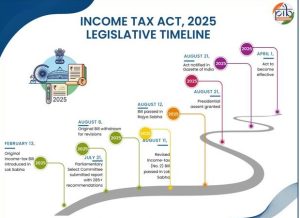India has officially notified the New Income Tax Act 2025, marking a historic transformation in the nation’s direct tax system. Taking effect from April 1, 2026, this modern law replaces the Income-tax Act of 1961, which has guided India’s tax structure for more than six decades.
Why does this matter to you? Because this law not only simplifies taxation but also aims to make compliance easier, transparent, and digital-friendly. Think of it as replacing an old machine with a smart one—faster, cleaner, and far more efficient.
Table of Contents
| Sr# | Headings |
| 1 | Introduction to the New Income Tax Act 2025 |
| 2 | Notification and Implementation Timeline |
| 3 | Objectives Behind the New Law |
| 4 | Key Highlights of the New Income Tax Act 2025 |
| 5 | The New Tax Regime under Clause 202(1) |
| 6 | Updated Income Tax Slabs and Rates |
| 7 | Income Tax Rebate under Section 87A |
| 8 | Eligibility and Exclusions for Rebate |
| 9 | Major Tax Reliefs and Compliance Simplifications |
| 10 | Select Committee’s Key Recommendations |
| 11 | Comparison: Income Tax Act 1961 vs. 2025 |
| 12 | Benefits for Individual and Corporate Taxpayers |
| 13 | Modernisation and Digital Transformation |
| 14 | Future Impact on Taxpayers and the Economy |
| 15 | Conclusion and Final Thoughts |
| 16 | FAQs on New Income Tax Act 2025 |
1. Introduction to the New Income Tax Act 2025
The New Income Tax Act 2025 introduces a fresh, streamlined structure for India’s taxation system. Designed to eliminate confusion and redundancy, it incorporates clarity, consistency, and fairness for all taxpayers.
2. Notification and Implementation Timeline
The Government of India notified the New Income Tax Act on August 22, 2025, following Parliament’s approval on August 11, 2025, and Presidential assent on August 21, 2025.
Importantly, the Act will come into effect from April 1, 2026, unless the government specifies another date.
3. Objectives Behind the New Law
The main goal of the New Income Tax Act 2025 is to modernise India’s direct tax system. It aims to:
- Simplify compliance for individuals and businesses.
- Reduce litigation by eliminating vague provisions.
- Align taxation with the needs of a digital economy.
- Incorporate public and expert feedback for clarity and inclusiveness.
4. Key Highlights of the New Income Tax Act 2025
The Central Government incorporated nearly 285 recommendations from the Select Committee and public consultations. This Act:
- Redefines tax slabs under a new regime.
- Carries forward important rebates from the previous law.
- Removes outdated clauses, and
- Improves transparency through precise legal language.
5. The New Tax Regime under Clause 202(1)
Under Clause 202(1), the new tax regime simplifies how taxes are calculated for individuals, HUFs, and other taxpayers.
It introduces clear income brackets and straightforward rates that make tax computation more predictable and transparent.
6. Updated Income Tax Slabs and Rates
Here’s how the new slab system looks:
| Income Range (INR) | Tax Rate |
| Up to 4,00,000 | No Tax |
| 4,00,001 – 8,00,000 | 5% |
| 8,00,001 – 12,00,000 | 10% |
| 12,00,001 – 16,00,000 | 15% |
| 16,00,001 – 20,00,000 | 20% |
| 20,00,001 – 24,00,000 | 25% |
| Above 24,00,000 | 30% |
This progressive structure ensures fairness and inclusivity, balancing relief for low-income earners while maintaining contributions from higher brackets.
7. Income Tax Rebate under Section 87A
The Section 87A rebate continues under the new Act with enhanced benefits.
- Under the old system, taxpayers could claim up to INR 12,500 as a rebate.
- Under the new regime, this limit rises to INR 60,000 or the full tax payable, whichever is lower.
This effectively reduces the tax burden for middle-class earners and encourages compliance.
8. Eligibility and Exclusions for Rebate
Only resident individuals can claim the Section 87A rebate.
However, the benefit does not apply to:
- Long-term capital gains (LTCG) from listed shares.
- LTCG from equity-oriented mutual funds under Section 112A.
These incomes continue to be taxed separately at 12.5%, ensuring balanced revenue collection.
9. Major Tax Reliefs and Compliance Simplifications
The new law introduces multiple taxpayer-friendly reforms, including:
- Tax exemption on commuted pensions, previously ambiguous in drafts.
- Removal of Alternate Minimum Tax (AMT) on LLPs.
- Relaxed rules for charitable trusts and transfer pricing.
These measures simplify filing, reduce compliance costs, and improve ease of doing business.
10. Select Committee’s Key Recommendations
The Select Committee made several impactful suggestions:
- Advance NIL-TDS certification for individuals with no tax liability.
- Elimination of notional rent-based taxation on vacant properties.
- Greater clarity in property income calculations.
- Simplified procedural norms for advance rulings and TDS.
- Reintroduction of Section 80M to avoid double taxation on dividends.
- Extended pension deductions for non-employees.
By accepting most recommendations, the government ensures that tax law becomes both practical and humane.
11. Comparison: Income Tax Act 1961 vs. 2025
| Aspect | Income Tax Act 1961 | Income Tax Act 2025 |
| Complexity | Highly complex, with multiple amendments | Streamlined and unified |
| Sections | 700+ sections | 536 sections and 16 schedules |
| Terminology | Previous Year, Assessment Year | Unified “Tax Year” |
| Compliance | Paper-heavy, slow | Digital-first, simplified |
| Governance | Limited clarity | CBDT empowered to adapt rules dynamically |
The New Income Tax Act 2025 truly brings a new era of simplicity and efficiency.
12. Benefits for Individual and Corporate Taxpayers
For individuals, the new system provides lower tax rates and greater rebates.
For businesses, it removes redundant levies like AMT on LLPs and clarifies deductions.
Overall, it boosts confidence, especially among startups and small enterprises.
13. Modernisation and Digital Transformation
The Act empowers the Central Board of Direct Taxes (CBDT) to frame adaptive rules suited for the digital economy.
From online filings to AI-driven audits, the focus is on transparency, automation, and accountability.
14. Future Impact on Taxpayers and the Economy
The New Income Tax Act 2025 is expected to:
- Enhance voluntary compliance,
- Reduce litigation,
- Promote fairness, and
- Strengthen investor confidence in India’s economic environment.
In essence, it modernizes India’s fiscal foundation for the next generation.
15. Conclusion and Final Thoughts
In conclusion, the New Income Tax Act 2025 represents a bold step forward in India’s tax reform journey. By simplifying structures, increasing rebates, and enabling digital integration, the Act seeks to empower taxpayers and streamline governance.
Think of it as India’s tax system getting a software upgrade—cleaner, faster, and smarter for everyone.
16. FAQs on New Income Tax Act 2025
- When will the New Income Tax Act 2025 come into effect?
It will be implemented from April 1, 2026, unless another date is announced by the government. - What are the new tax slab rates under the 2025 Act?
The slabs start with no tax up to ₹4 lakh and rise progressively to 30% for income above ₹24 lakh. - Does the Section 87A rebate continue under the new law?
Yes, and it’s enhanced—up to ₹60,000 or full tax payable, whichever is lower. - What key benefits does the new Act provide for businesses?
It removes AMT on LLPs, simplifies compliance, and aligns MSME definitions with the MSME Act. - How is the New Income Tax Act 2025 different from the old one?
It’s simpler, more transparent, and digitally adaptive, replacing outdated provisions from the 1961 Act.





